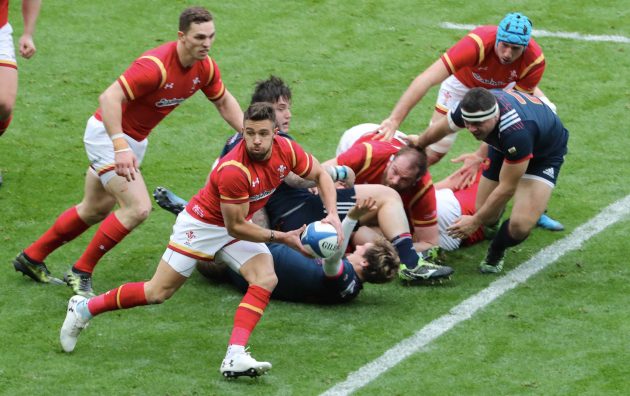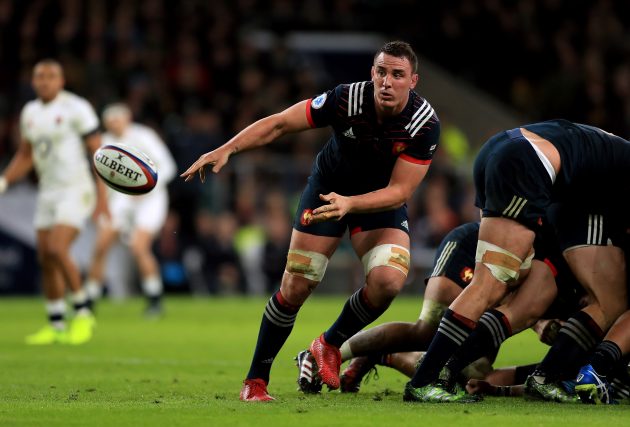The Six Nations brought intrigue, drama and lashings of entertainment but who were the individual stars of the show and shone in their position?
By Alex Shaw
The 2017 RBS Six Nations is in the books. The national animosities can be put back in the cupboard until, well, the British and Irish Lions squad announcement next month. England successfully defended their title, but were left with a bittersweet taste in their mouth as Ireland ruined their Grand Slam party in Dublin, Italy look adrift at the bottom of the log and as for the other four nations, there was a mix of positives and negatives to take away from the tournament. We round up our XV of the championship as we bid farewell to the Six Nations for another year and turn our attentions back to the club game and the business end of the domestic season.
15. Stuart Hogg, Scotland
Mike Brown and Leigh Halfpenny had their moments but for consistency and game-changing impact across the five rounds, Hogg comfortably slots in here at 15. Whether he is linking the midfield with the wings, acting as a first or second receiver in the line or picking an angle on the shoulder of a carrier, Hogg is always adding something to the Scottish attack. There were a couple of defensive errors here and there but his tactical kicking was excellent, either raking the touchline for every metre he could get or giving his contestable kicks just enough air to ensure his chasers could compete.

Bouncing: Stuart Hogg was an ever-present threat at full-back
14. Keith Earls, Ireland
There was a strong late push from George North for this spot, something which bodes well for the Lions tour, but over the entire tournament no right wing threatened and caused as many problems as Earls did. The Munster man invariably beat the first up tackler whenever he took the ball in anything close to resembling space and repeatedly put the Irish team on the front-foot. His jinking runs may have been the attacking highlight of Ireland’s Six Nations and were the most reliable offensive weapon that Joe Schmidt had in his arsenal.
13. Gaël Fickou, France
It was hard to separate the outside centres, with Jonathan Joseph, Garry Ringrose, Jonathan Davies, Huw Jones and Michele Campagnaro all having an excellent game or two, but none of whom showed that incisive attacking ability or reliability in defence across all five rounds. Instead, we opt for the French inside centre, making room at 12 for another player who, just like Fickou, consistently performed throughout the championship. Fickou is not a “by default” selection here, either, as the Frenchman shone in the notoriously inconsistent Les Bleus back line, re-injecting some much-needed joie de vivre into the group. His ability to spot a gap and then capitalise upon it remains unmatched in the French team.

Making space: Gael Fickou has been a key cog in the French midfield
12. Owen Farrell, England
Not a vintage year by Owen Farrell’s standards but he still set himself apart as, by a distance, the best inside centre in the northern hemisphere. Fickou also impressed but was moved out to 13 for the purposes of this XV, leaving a slightly under-utilised Scott Williams as Farrell’s biggest competition. Resolute defence, a steady stream of points with the boot, clinical linebreaks and composed passing, Farrell delivered everything you could ask of an inside centre. At his best, he was unplayable, but even when England as a whole were struggling, he still executed at a level that allowed them to win, most notably against France and Wales.
11. Elliot Daly, England
Liam Williams came close and deserves an honourable mention, as does Scotland’s Tim Visser, but Daly is beginning to show why Eddie Jones has put so much faith in him as a winger. Everyone knows that Daly has the footwork and pace to make himself a threat out wide, but it wasn’t in this way that he caught the eye. It was his defensive positioning, tactical kicking off his left boot and cover tackling that set him apart this year. It’s not the sexiest list of attributes but they are some of the harder nuances of wing play to pick up and he seems to have mastered them very quickly for someone having to learn on-the-fly in the Test arena.

Match winner: Elliot Daly broke Welsh hearts in Cardiff
10. Finn Russell, Scotland
People will point to a few Russell errors over the course of the tournament but the same can be said of George Ford, Dan Biggar or any other fly-half over the last seven weeks. Jonathan Sexton probably came closest to Russell but still didn’t pull the strings of the Irish back line with quite the clinical nature we have become accustomed to. Bringing in and blooding Russell on his first tour as head coach may be Vern Cotter’s greatest accomplishment during his time in Scotland, as he has become the first fly-half since Gregor Townsend that Scotland can be confident about building a prolific attack around. He was quiet on trips to Paris and Twickenham but more than held serve at BT Murrayfield, helping deliver Scotland’s first three-win haul in the Six Nations for 11 years.
9. Rhys Webb, Wales
Conor Murray was solid and possibly still has the advantage on Webb in terms of the upcoming Lions tour, but the Welshman was a dynamo at nine and injected the tempo into Wales that coincided with some of the best moments of their tournament. The remonstrating with referees and pats on the head of opposition players don’t go down well with fans, but you cannot argue the effervescence of Webb on the pitch. His sniping runs were one of Wales’ most reliable attacking weapons, whilst his passing was also crisp and accurate.

Perpetual motion: Rhys Webb was irrepressible throughout the tournament
1. Cyril Baille, France
It was definitely a year for tightheads but if there was one player who bucked that trend, it was Baille. Rob Evans, Joe Marler and Jack McGrath all had their moments, but none as consistently as the Frenchman. The Toulouse loosehead was a force at the scrum, had the level of conditioning that saw him thrive well into the second half – seemingly a rarity among French props these days – and he was no slouch as a carrier, either, often probing the fringes with powerful, if not spectacular, forays.
France may have found their No 1 for the best part of the next decade.
2. Ken Owens, Wales
Wales’ own Mr Reliable, Owens’ stock rose dramatically over the last seven weeks and he has thrown his hat well and truly into the Lions mix. Owens posted the highest lineout accuracy of the tournament, with Dylan Hartley and Fraser Brown trailing in second and third respectively, whilst many people’s Lions favourite, Rory Best, was some way off in fifth. The Welshman also delivered with ball-in-hand, carrying and offloading well, often keeping phases alive and stretching opposition defences.

Form run: Ken Owens’ performances have led to calls for a Lions place
3. Tadgh Furlong, Ireland
This was a tough one. Dan Cole really grew into the tournament and by the final two rounds was approaching something close to his best, but for consistency across all five games, Furlong just has the edge. It’s a nice selection dilemma for Warren Gatland, too.
Furlong’s rise has coincided with Ireland transitioning from a team that had sporadic scrum success to one that may be the premiere group in world rugby. It is possible that Furlong’s tournament doesn’t as look as effective because of a quiet campaign from front row partner McGrath, but the farm-strong tighthead constantly had his side of the scrum anchored. He delivered effectively in the loose, too.
4. Donnacha Ryan, Ireland
The most honourable of mentions must go to Joe Launchbury here, who, the game with Ireland aside, never dipped below excellent with his performances, but Ryan seemed to be the emotional lightning rod that galvanised Ireland, particularly in that game with England. Ryan is showing that although the era of the new breed of ultra-athletic second rows has arrived, the old dogs still have some tricks up their sleeves. His defensive and breakdown work was impressive throughout the championship and without his skills as a defensive communicator, Ireland may not have managed the three wins they recorded. Just keep the imaginary cards in the pocket next time, Donnacha.

Strong arm: Donnacha Ryan put in some muscular performances in Ireland’s engine room
5. Maro Itoje, England
Speaking of that new breed of ultra-athletic second rows, enter stage right Itoje, hybrid lineout savant and enforcer.
The Saracen saw less action with the ball-in-hand this year, given the absences of George Kruis and Chris Robshaw were covered by more prolific carriers in Launchbury and Courtney Lawes, but he has found new ways to contribute in the re-jigged balance of the England pack. His line speed throughout the tournament was excellent and he was regularly used as a primary chaser on kicks with wings Daly and Jonny May. Parcel in his contributions at the breakdown and as a defensive communicator – with England missing two of their best in Kruis and Robshaw – and it was a fine tournament for the lock, albeit in a less eye-catching style than last year.
6. Courtney Lawes, England
This could easily have been Sam Warburton, with the former Wales captain excelling and laying down Lions credentials each and every round, but so did Lawes. They were hard to separate and maybe it’s the fact that Lawes was playing out of his accustomed position that tipped the scales in his favour. As an enforcing second row with the ability to steal opposition lineout ball, Lawes was already as good as the northern hemisphere had to offer, but by adding a lower body position to his carries and an increased work rate – he averaged 23.6 combined tackles and carries per game – he has made himself an even better second row and a legitimate option in the back row.

Argy-bargy: Courtney Lawes gets entangled with Richie Gray
7. Hamish Watson, Scotland
Kevin Gourdon and Justin Tipuric both had their moments but neither with such impact or consistency as Watson, who, just like Owens, improved his Lions stock immeasurably with an almost flawless Six Nations. A key cog in Scotland’s ability to generate quick ball, Watson made up for the absence of John Hardie with aplomb and provided plenty of go forward with his carries, too. He was staunch in defence and hit ball-carriers on the gain-line with a piston-like ferocity. If the tournament awarded a “Most Improved Player” award, it would surely go to Watson this year.
8. Louis Picamoles, France
Ryan Wilson and Jamie Heaslip were solid and Sergio Parisse flashed moments of brilliance but Picamoles combined the reliability of the first two with the Italian’s flair and turned in the best championship of any No 8. Combined with the likes of Baille, Fickou and Baptiste Serin, Picamoles gives France the energy and urgency they need and his ability to execute is rarely, if ever, compromised as a result. That composure and skill to execute and think on the fly is hard to develop in players once they have reached the senior level and for a while now France have lacked that kind of player. It’s something which needs to be addressed at all levels in French rugby but one thing is for sure, Picamoles has it in abundance.





